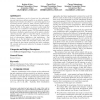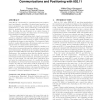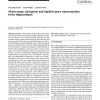403 search results - page 63 / 81 » Mapping indoor environments based on human activity |
SOFTVIS
2010
ACM
14 years 11 months ago
2010
ACM
Software visualization can be of great use for understanding and exploring a software system in an intuitive manner. Spatial representation of software is a promising approach of ...
HRI
2007
ACM
15 years 3 months ago
2007
ACM
The goal of the RUBI project is to accelerate progress in the development of social robots by addressing the problem at multiple levels, including the development of new scientifi...
MOBISYS
2008
ACM
15 years 11 months ago
2008
ACM
Using 802.11 concurrently for communications and positioning is problematic, especially if location-based services (e.g., indoor navigation) are concurrently executed with real-ti...
BC
2006
14 years 11 months ago
2006
Abstract Multiple sensory-motor maps located in the brainstem and the cortex are involved in spatial orientation. Guiding movements of eyes, head, neck and arms they provide an app...
ISBI
2004
IEEE
16 years 14 hour ago
2004
IEEE
Functional MRI studies commonly refer to activation patterns as being localized in specific Brodmann areas, referring to Brodmann's divisions of the human cortex based on cyt...



